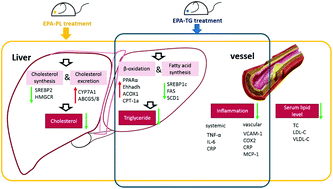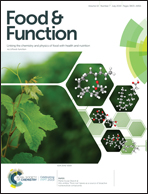Eicosapentaenoic acid in the form of phospholipids exerts superior anti-atherosclerosis effects to its triglyceride form in ApoE−/− mice†
Abstract
Dietary eicosapentaenoic acid (EPA), a main component of fish oil, has been proved to reduce the risk of cardiovascular disease. The purpose of this study was to investigate whether the anti-atherosclerosis effect of fish oil enriched with EPA partially relied on its chemical groups at the sn-3 position. Male ApoE−/− mice were divided into three groups and were fed a high-fat diet (Model) or a high-fat diet containing EPA incorporated into phospholipids (EPA-PL) or triglycerides (EPA-TG), respectively. Compared with the model group, a decrease in the area of atherosclerosis lesions at the aorta was observed in both EPA-treated groups, in which EPA-PL was superior to EPA-TG. Notably, EPA-PL exhibited lower serum and hepatic lipid levels than the model group, whereas EPA-TG only reduced the hepatic triglyceride level. Interestingly, only EPA-PL treatment regulated the expression of genes involved in cholesterol metabolism. In addition, EPA-PL and EPA-TG suppressed the inflammation markers in the aorta and circulation. In conclusion, EPA-PL was superior to EPA-TG in reducing lesion progression by modulating the hepatic lipid metabolism, as well as decreasing the inflammation in the artery wall and circulatory system, which might be attributed to their structural differences at the sn-3 position.



 Please wait while we load your content...
Please wait while we load your content...